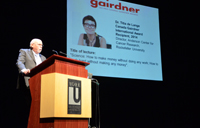
More than 300 Grade 12 students and their teachers visited York University’s Keele campus for the 2014 Gairdner Foundation Student Outreach lecture Oct. 29. The lecture took place in the Sandra Faire and Ivan Fecan Theatre.
Titia de Lange, the 2014 Canada Gairdner International Award Laureate, and Molly Shoichet, Canada Research Chair in Tissue Engineering and a professor of chemical engineering & applied chemistry, chemistry and biomaterials & biomedical engineering at the University of Toronto, shared stories of their academic and professional experiences in the scientific research field with the students and their teachers.
de Lange delivered an entertaining speech with anecdotes about her free-spirited teenage years spent sneaking into Woodstock events in her home town of Rotterdam, Holland, before settling into science. de Lange’s story about her education and a career path, which eventually led her to win the Gairdner Award, was refreshing and suited to the predominantly teenage audience. She advised students to select a field they would love. “No job you hold will ever feel like work if your passion drives you to it,” she said. It was with this philosophical outlook she took with her when she began studying science. She wanted to satisfy her curiosity for biology and, more specifically, chromosomes. “I had a crush on chromosomes,” said de Lange. “I thought they were amazing.”

It was this crush that motivated de Lange to study at the University of Amsterdam in 1974, when only one per cent of the faculty was female. She recounted how her experiences from research on beta-globin genes done with Piet Borst in London, U.K., to her postdoctoral work with Nobel Prize winner and cancer researcher Harold Varmus shaped much of her academic career. de Lange’s combined experiences eventually led her to The Rockefeller University in New York City where she now researches what she describes as “fascinating” telomeres. de Lange closed with an overview of her research work which focuses on determining how telomeres protect human DNA, as well as the investigation of cell growth, chromosome integrity and human disorders including cancer and aging.
Schoichet took the stage next. She spoke about how her passion for chemistry inspired her to study at the Massachusetts Institute of Technology, where she completed her bachelor of science, and the University of Massachusetts, where she completed her master’s and doctoral degrees. Schoichet’s talk also outlined her career path and reinforced the theme of following one’s interests. She credited her success to hard work, practice and dedication in a field that continues to motivate and excite her. Students heard about her research, which uses stem cells for regenerative medicine, and asked multiple questions about its application to neurodegenerative diseases such as spinal cord and brain injury.

On-campus recruitment events play an important role as students decide which university they’ll apply to. Judy O’Leary, health-care science teacher at Jean Vanier Catholic Secondary School in Scarborough, encouraged her students to spend the day at York University not only to hear from researchers in science, but also to catch a glimpse of university life. “They need the experience of what university lectures are like, to walk around campus and really get a feel for it,” said O’Leary. “It’s important to go for the experience and not be pigeon-holed into choosing certain schools that other students talk about. They need to pick what’s a good fit for them.”
Students spent the remainder of their visit participating in science-specific tours and campus tours, and spoke with current York students studying in the Faculty of Science. Many students were already interested in a variety of different scientific fields while others were looking for direction. Grade 12 student Armand from Martingrove Collegiate Institute said he is keeping his options open. “I don’t have any real plan after high school, so I’m learning for the sake of learning and figuring out what to do. I’m looking toward health sciences or business,” said Armand. “I don’t want to be put into a position of pick a career and go. I want to know what I’m getting myself into, so events like these really help.”

Next up is Fall Campus Day on Nov. 8, when a larger influx of high-school students and their parents will visit the Keele campus. The annual event attracts more than 3,000 visitors (many of them newly admitted students who have not yet accepted their offers of admission to York) interested in learning more about York’s programs, exploring campus, experiencing labs, libraries and classrooms, and attending information sessions. The Glendon campus hosts its Fall Campus Day on Nov. 9. Events include information sessions, academics and support services fairs, campus tours and a residence open house.


